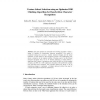Free Online Productivity Tools
i2Speak
i2Symbol
i2OCR
iTex2Img
iWeb2Print
iWeb2Shot
i2Type
iPdf2Split
iPdf2Merge
i2Bopomofo
i2Arabic
i2Style
i2Image
i2PDF
iLatex2Rtf
Sci2ools
133
click to vote
SSPR
2004
Springer
2004
Springer
Feature Subset Selection Using an Optimized Hill Climbing Algorithm for Handwritten Character Recognition
This paper presents an optimized Hill Climbing algorithm to select a subset of features for handwritten character recognition. The search is conducted taking into account a random mutation strategy and the initial relevance of each feature in the recognition process. The experiments have shown a reduction in the original number of features used in an MLP-based character recognizer from 132 to 77 features (reduction of 42%) without a significant loss in terms of recognition rates, which are 99% for 60,089 samples of digits, and 93% for 11,941 uppercase characters, both handwritten samples from the NIST SD19 database. The proposed method has shown to be an interesting strategy to implement a wrapper approach without the need of complex and expensive hardware architectures.
Handwritten Character Recognition | Hill Climbing Algorithm | Pattern Recognition | Random Mutation Strategy | SSPR 2004 |
| Added | 02 Jul 2010 |
| Updated | 02 Jul 2010 |
| Type | Conference |
| Year | 2004 |
| Where | SSPR |
| Authors | Carlos M. Nunes, Alceu de Souza Britto Jr., Celso A. A. Kaestner, Robert Sabourin |
Comments (0)

